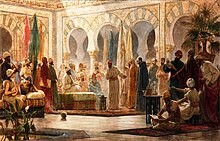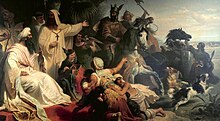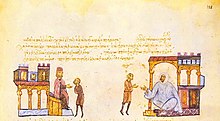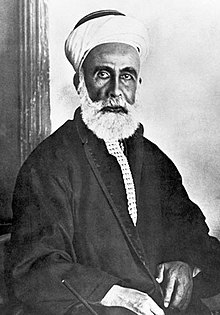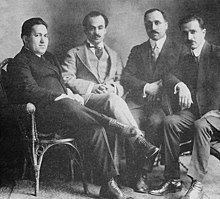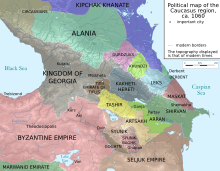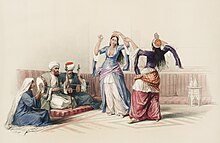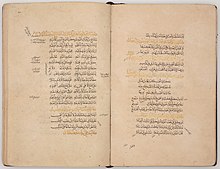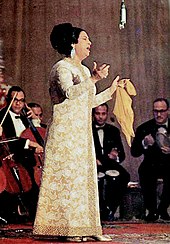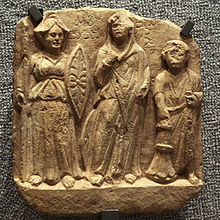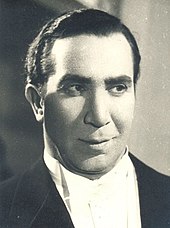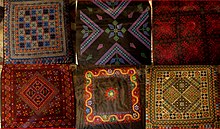Arabian People
Arabs have been in the Fertile Crescent for thousands of years. In the 9th century BCE, the Assyrians made written references to Arabs as inhabitants of the Levant, Mesopotamia, and Arabia. Throughout the Ancient Near East, Arabs established influential civilizations starting from 3000 BCE onwards, such as Dilmun, Gerrha, and Magan, playing a vital role in trade between Mesopotamia, and the Mediterranean. Other prominent tribes include Midian, ʿĀd, and Thamud mentioned in the Bible and Quran. Later, in 900 BCE, the Qedarites enjoyed close relations with the nearby Canaanite and Aramaean states, and their territory extended from Lower Egypt to the Southern Levant. From 1200 BCE to 110 BCE, powerful kingdoms emerged such as Saba, Lihyan, Minaean, Qataban, Hadhramaut, Awsan, and Homerite emerged in Arabia. According to the Abrahamic tradition, Arabs are descendants of Abraham through his son Ishmael.

During classical antiquity, the Nabataeans established their kingdom with Petra as the capital in 300 BCE, by 271 CE, the Palmyrene Empire with the capital Palmyra, led by Queen Zenobia, encompassed the Syria Palaestina, Arabia Petraea, Egypt, and large parts of Anatolia. The Arab Itureans inhabited Lebanon, Syria, and northern Palestine (Galilee) during the Hellenistic and Roman periods. The Osroene and Hatran were Arab kingdoms in Upper Mesopotamia around 200 CE. In 164 CE, the Sasanians recognized the Arabs as "Arbayistan", meaning "land of the Arabs," as they were part of Adiabene in upper Mesopotamia. The Arab Emesenes ruled by 46 BCE Emesa (Homs), Syria. During late antiquity, the Tanukhids, Salihids, Lakhmids, Kinda, and Ghassanids were dominant Arab tribes in the Levant, Mesopotamia, and Arabia, they predominantly embraced Christianity.
During the Middle Ages, Islam fostered a vast Arab union, leading to significant Arab migrations to the Maghreb, the Levant, and neighbouring territories under the rule of Arab empires such as the Rashidun, Umayyad, Abbasid, and Fatimid, ultimately leading to the decline of the Byzantine and Sasanian empires. At its peak, Arab territories stretched from southern France to western China, forming one of history's largest empires. The Great Arab Revolt in the early 20th century aided in dismantling the Ottoman Empire, ultimately leading to the formation of the Arab League on 22 March 1945, with its Charter endorsing the principle of a "unified Arab homeland".
Arabs from Morocco to Iraq share a common bond based on ethnicity, language, culture, history, identity, ancestry, nationalism, geography, unity, and politics, which give the region a distinct identity and distinguish it from other parts of the Muslim world. They also have their own customs, literature, music, dance, media, food, clothing, society, sports, architecture, art and, mythology. Arabs have significantly influenced and contributed to human progress in many fields, including science, technology, philosophy, ethics, literature, politics, business, art, music, comedy, theatre, cinema, architecture, food, medicine, and religion. Before Islam, most Arabs followed polytheistic Semitic religion, while some tribes adopted Judaism or Christianity and a few individuals, known as the hanifs, followed a form of monotheism. Currently, around 93% of Arabs are Muslims, while the rest are mainly Arab Christians, as well as Arab groups of Druze and Baháʼís.
Etymology

The earliest documented use of the word Arab in reference to a people appears in the Kurkh Monoliths, an Akkadian-language record of the Assyrian conquest of Aram (9th century BCE). The Monoliths used the term to refer to Bedouins of the Arabian Peninsula under King Gindibu, who fought as part of a coalition opposed to Assyria.
The related word ʾaʿrāb is used to refer to Bedouins today, in contrast to ʿArab which refers to Arabs in general. Both terms are mentioned around 40 times in pre-Islamic Sabaean inscriptions. The term ʿarab ('Arab') occurs also in the titles of the Himyarite kings from the time of 'Abu Karab Asad until MadiKarib Ya'fur. According to Sabaean grammar, the term ʾaʿrāb is derived from the term ʿarab. The term is also mentioned in Quranic verses, referring to people who were living in Madina and it might be a south Arabian loanword into Quranic language.
The oldest surviving indication of an Arab national identity is an inscription made in an archaic form of Arabic in 328 CE using the Nabataean alphabet, which refers to Imru' al-Qays ibn 'Amr as 'King of all the Arabs'. Herodotus refers to the Arabs in the Sinai, southern Palestine, and the frankincense region (Southern Arabia). Other Ancient-Greek historians like Agatharchides, Diodorus Siculus and Strabo mention Arabs living in Mesopotamia (along the Euphrates), in Egypt (the Sinai and the Red Sea), southern Jordan (the Nabataeans), the Syrian steppe and in eastern Arabia (the people of Gerrha). Inscriptions dating to the 6th century BCE in Yemen include the term 'Arab'.
The most popular Arab account holds that the word Arab came from an eponymous father named Ya'rub, who was supposedly the first to speak Arabic. Abu Muhammad al-Hasan al-Hamdani had another view; he states that Arabs were called gharab ('westerners') by Mesopotamians because Bedouins originally resided to the west of Mesopotamia; the term was then corrupted into Arab.
Yet another view is held by al-Masudi that the word Arab was initially applied to the Ishmaelites of the Arabah valley. In Biblical etymology, Arab (Hebrew: arvi) comes from the desert origin of the Bedouins it originally described (arava means 'wilderness').
The root ʿ-r-b has several additional meanings in Semitic languages—including 'west, sunset', 'desert', 'mingle', 'mixed', 'merchant' and 'raven'—and are "comprehensible" with all of these having varying degrees of relevance to the emergence of the name. It is also possible that some forms were metathetical from ʿ-B-R, 'moving around' (Arabic: ʿ-B-R, 'traverse') and hence, it is alleged, 'nomadic'.
Origins

Arabic is a Semitic language that belongs to the Afroasiatic language family. The majority of scholars accept the "Arabian peninsula" has long been accepted as the original Urheimat (linguistic homeland) of the Semitic languages. with some scholars investigating if its origins are in the Levant. The ancient Semitic-speaking peoples lived in the ancient Near East, including the Levant, Mesopotamia, and the Arabian Peninsula from the 3rd millennium BCE to the end of antiquity. Proto-Semitic likely reached the Arabian Peninsula by the 4th millennium BCE, and its daughter languages spread outward from there, while Old Arabic began to differentiate from Central Semitic by the start of the 1st millennium BCE. Central Semitic is a branch of the Semitic language includes Arabic, Aramaic, Canaanite, Phoenician, Hebrew and others. The origins of Proto-Semitic may lie in the Arabian Peninsula, with the language spreading from there to other regions. This theory proposes that Semitic peoples reached Mesopotamia and other areas from the deserts to the west, such as the Akkadians who entered Mesopotamia around the late 4th millennium BCE. The origins of Semitic peoples are thought to include various regions Mesopotamia, the Levant, the Arabian Peninsula, and North Africa. Some view that Semitic may have originated in the Levant around 3800 BCE and subsequently spread to the Horn of Africa around 800 BCE from Arabia, as well as to North Africa.
According to Arab–Islamic–Jewish traditions, Ishmael, the son of Abraham and Hagar was "father of the Arabs". Ishmael was considered the ancestor of the Islamic prophet Muhammad, the founder of Islam. The tribes of Central West Arabia called themselves the "people of Abraham and the offspring of Ishmael." Ibn Khaldun, an Arab scholar in the 8th century, described the Arabs as having Ishmaelite origins.
The Quran mentions that Ibrahim (Abraham) and his wife Hajar (Hagar) bore a prophetic child named Ishmael, who was gifted by God a favor above other nations. Ibrahim and Ishmael built the Kaaba in Mecca, which was originally constructed by Adam. According to the Samaritan book Asaṭīr: "And after the death of Abraham, Ishmael reigned twenty-seven years; And all the children of Nebaot ruled for one year in the lifetime of Ishmael; And for thirty years after his death from the river of Egypt to the river Euphrates; and they built Mecca." The Targum Onkelos annotates (Genesis 25:16), describing the extent of their settlements: The Ishmaelites lived from Hindekaia (India) to Chalutsa (possibly in Arabia), by the side of Mizraim (Egypt), and from the area around Arthur (Assyria) up towards the north. This description suggests that the Ishmaelites were a widely dispersed group with a presence across a significant portion of the ancient Near East.
History
The nomads of Arabia have been spreading through the desert fringes of the Fertile Crescent since at least 3000 BCE, but the first known reference to the Arabs as a distinct group is from an Assyrian scribe recording a battle in 853 BCE. The history of the Arabs during the pre-Islamic period in various regions, including Arabia, Levant, Mesopotamia, and Egypt. The Arabs were mentioned by their neighbors, such as Assyrian and Babylonian Royal Inscriptions from 9th to 6th century BCE. There are also records from Sargon's reign that mention sellers of iron to people called Arabs in Ḫuzaza in Babylon, causing Sargon to prohibit such trade out of fear that the Arabs might use the resource to manufacture weapons against the Assyrian army. The history of the Arabs in relation to the Bible shows that they were a significant part of the region and played a role in the lives of the Israelites. The study asserts that the Arab nation is an ancient and significant entity; however, it highlights that the Arabs lacked a collective awareness of their unity. They did not inscribe their identity as Arabs or assert exclusive ownership over specific territories.
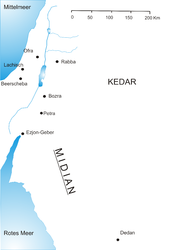
Magan, Midian, and ʿĀd are all ancient tribes or civilizations that are mentioned in Arabic literature and have roots in the Arabia. Magan (Arabic: مِجَانُ, Majan), known for its production of copper and other metals, the region was an important trading center in ancient times and is mentioned in the Qur'an as a place where Musa (Moses) traveled during his lifetime. Midian (Arabic: مَدْيَن, Madyan), on the other hand, was a region located in the northwestern part of the Arabia, the people of Midian are mentioned in the Qur'an as having worshiped idols and having been punished by God for their disobedience. Moses also lived in Midian for a time, where he married and worked as a shepherd. ʿĀd (Arabic: عَادَ, ʿĀd), as mentioned earlier, was an ancient tribe that lived in the southern Arabia, the tribe was known for its wealth, power, and advanced technology, but they were ultimately destroyed by a powerful windstorm as punishment for their disobedience to God. ʿĀd is regarded as one of the original Arab tribes. The historian Herodotus provided extensive information about Arabia, describing the spices, terrain, folklore, trade, clothing, and weapons of the Arabs. In his third book, he mentioned the Arabs as a force to be reckoned with in the north of the Arabian Peninsula just before Cambyses' campaign against Egypt. Other Greek and Latin authors who wrote about Arabia include Theophrastus, Strabo, Diodorus Siculus, and Pliny the Elder. The Jewish historian Flavius Josephus wrote about the Arabs and their king, mentioning their relationship with Cleopatra, the queen of Egypt. The tribute paid by the Arab king to Cleopatra was collected by Herod, the king of the Jews, but the Arab king later became slow in his payments and refused to pay without further deductions. Geshem the Arab was an Arab man who opposed Nehemiah in the Hebrew Bible (Neh. 2:19, 6:1). He was likely the chief of the Arab tribe "Gushamu" and have been a powerful ruler with influence stretching from northern Arabia to Judah. The Arabs and the Samaritans made efforts to hinder Nehemiah's rebuilding of the walls of Jerusalem.
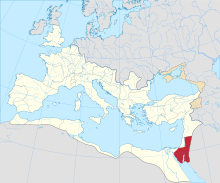

The term "Saracens" was a term used in the early centuries, both in Greek and Latin writings, to refer to the "Arabs" who lived in and near what was designated by the Romans as Arabia Petraea (Levant) and Arabia Deserta (Arabia). The Christians of Iberia used the term Moor to describe all the Arabs and Muslims of that time. Arabs of Medina referred to the nomadic tribes of the deserts as the A'raab, and considered themselves sedentary, but were aware of their close racial bonds. Hagarenes is a term widely used by early Syriac, Greek, and Armenian to describe the early Arab conquerors of Mesopotamia, Syria and Egypt, refers to the descendants of Hagar, who bore a son named Ishmael to Abraham in the Old Testament. In the Bible, the Hagarenes referred to as "Ishmaelites" or "Arabs." The Arab conquests in the 7th century was a sudden and dramatic conquest led by Arab armies, which quickly conquered much of the Middle East, North Africa, and Spain. It was a significant moment for Islam, which saw itself as the successor of Judaism and Christianity.
Antiquity

Limited local historical coverage of these civilizations means that archaeological evidence, foreign accounts and Arab oral traditions are largely relied on to reconstruct this period. Prominent civilizations at the time included, Dilmun civilization was an important trading centre which at the height of its power controlled the Arabian Gulf trading routes. The Sumerians regarded Dilmun as holy land. Dilmun is regarded as one of the oldest ancient civilizations in the Middle East. which arose around the 4th millennium BCE and lasted to 538 BCE. Gerrha was an ancient city of Eastern Arabia, on the west side of the Gulf, Gerrha was the center of an Arab kingdom from approximately 650 BCE to circa CE 300. Thamud, which arose around the 1st millennium BCE and lasted to about 300 CE. From the beginning of the first millennium BCE, Proto-Arabic, or Ancient North Arabian, texts give a clearer picture of the Arabs' emergence. The earliest are written in variants of epigraphic south Arabian musnad script, including the 8th century BCE Hasaean inscriptions of eastern Saudi Arabia, the Thamudic texts found throughout the Arabian Peninsula and Sinai.
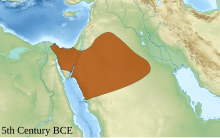
The Qedarites were a largely nomadic ancient Arab tribal confederation centred in the Wādī Sirḥān in the Syrian Desert. They were known for their nomadic lifestyle and for their role in the caravan trade that linked the Arabian Peninsula with the Mediterranean world. The Qedarites gradually expanded their territory over the course of the 8th and 7th centuries BCE, and by the 6th century BCE, they had consolidated into a kingdom that covered a large area in northern Arabia, southern Palestine, and the Sinai Peninsula. The Qedarites were influential in the ancient Near East, and their kingdom played a significant role in the political and economic affairs of the region for several centuries.

Sheba (Arabic: سَبَأٌ Saba) is kingdom mentioned in the Hebrew Bible (Old Testament) and the Quran, though Sabaean was a South Arabian languaged and not an Arabic one. Sheba features in Jewish, Muslim, and Christian traditions, whose lineage goes back to Qahtan son of Hud, one of the ancestors of the Arabs, Sheba was mentioned in Assyrian inscriptions and in the writings of Greek and Roman writers. One of the ancient written references that also spoke of Sheba is the Old Testament, which stated that the people of Sheba supplied Syria and Egypt with incense, especially frankincense, and exported gold and precious stones to them.

Sabaeans are mentioned several times in the Hebrew Bible. In the Quran, they are described as either Sabaʾ (سَبَأ, not to be confused with Ṣābiʾ, صَابِئ), or as Qawm Tubbaʿ (Arabic: قَوْم تُبَّع, lit. 'People of Tubbaʿ'). They were known for their prosperous trade and agricultural economy, which was based on the cultivation of frankincense and myrrh. These highly valued aromatic resins were exported to Egypt, Greece, and Rome, making the Sabaeans wealthy and powerful, they also traded in spices, textiles, and other luxury goods. The Maʾrib Dam was one of the greatest engineering achievements of the ancient world, and it provided water for the city of Maʾrib and the surrounding agricultural lands.
Lihyan also called Dadān or Dedan was a powerful and highly organized ancient Arab kingdom that played a vital cultural and economic role in the north-western region of the Arabian Peninsula and used Dadanitic language. The Lihyanites were known for their advanced organization and governance, and they played a significant role in the cultural and economic life of the region. The kingdom was centered around the city of Dedan (modern-day Al Ula), and it controlled a large territory that extended from Yathrib in the south to parts of the Levant in the north. The Arab genealogies consider the Banu Lihyan to be Ishmaelites, and used Dadanitic language.
The Kingdom of Ma'in was an ancient Arab kingdom with a hereditary monarchy system and a focus on agriculture and trade. Proposed dates range from the 15th century BCE to the 1st century CE Its history has been recorded through inscriptions and classical Greek and Roman books, although the exact start and end dates of the kingdom are still debated. The Ma'in people had a local governance system with councils called "Mazood," and each city had its own temple that housed one or more gods. They also adopted the Phoenician alphabet and used it to write their language. The kingdom eventually fell to the Arab Sabaean people.

Qataban was an ancient kingdom located in the South Arabia, which existed from the early 1st millennium BCE till the late 1st or 2nd centuries CE. It developed into a centralized state in the 6th century BCE with two co-kings ruling poles. Qataban expanded its territory, including the conquest of Ma'in and successful campaigns against the Sabaeans. It challenged the supremacy of the Sabaeans in the region and waged a successful war against Hadramawt in the 3rd century BCE. Qataban's power declined in the following centuries, leading to its annexation by Hadramawt and Ḥimyar in the 1st century CE.
The Kingdom of Hadhramaut it was known for its rich cultural heritage, as well as its strategic location along important trade routes that connected the Middle East, South Asia, and East Africa. The Kingdom was established around the 3rd century BCE, and it reached its peak during the 2nd century CE, when it controlled much of the southern Arabian Peninsula. The kingdom was known for its impressive architecture, particularly its distinctive towers, which were used as watchtowers, defensive structures, and homes for wealthy families. The people of Hadhramaut were skilled in agriculture, especially in growing frankincense and myrrh. They had a strong maritime culture and traded with India, East Africa, and Southeast Asia. Although the kingdom declined in the 4th century, Hadhramaut remained a cultural and economic center. Its legacy can still be seen today.

The ancient Kingdom of Awsān (8th–7th century BCE) was indeed one of the most important small kingdoms of South Arabia, and its capital Ḥajar Yaḥirr was a significant center of trade and commerce in the ancient world. The destruction of the city in the 7th century BCE by the king and Mukarrib of Saba' Karab El Watar is a significant event in the history of South Arabia. The victory of the Sabaeans over Awsān is also a testament to the military might and strategic prowess of the Sabaeans, who were one of the most powerful and influential kingdoms in the region.
The Himyarite Kingdom or Himyar, was an ancient kingdom that existed from around the 2nd century BCE to the 6th century CE. It was centered in the city of Zafar, which is located in present-day Yemen. The Himyarites were an Arab people who spoke a South Arabian language and were known for their prowess in trade and seafaring, they controlled the southern part of Arabia and had a prosperous economy based on agriculture, commerce, and maritime trade, they were skilled in irrigation and terracing, which allowed them to cultivate crops in the arid environment. The Himyarites converted to Judaism in the 4th century CE, and their rulers became known as the "Kings of the Jews", this conversion was likely influenced by their trade connections with the Jewish communities of the Red Sea region and the Levant, however, the Himyarites also tolerated other religions, including Christianity and the local pagan religions.
Classical antiquity
The Nabataeans were nomadic Arabs who settled in a territory centred around their capital of Petra in what is now Jordan. Their early inscriptions were in Aramaic, but gradually switched to Arabic, and since they had writing, it was they who made the first inscriptions in Arabic. The Nabataean alphabet was adopted by Arabs to the south, and evolved into modern Arabic script around the 4th century. This is attested by Safaitic inscriptions (beginning in the 1st century BCE) and the many Arabic personal names in Nabataean inscriptions. From about the 2nd century BCE, a few inscriptions from Qaryat al-Faw reveal a dialect no longer considered proto-Arabic, but pre-classical Arabic. Five Syriac inscriptions mentioning Arabs have been found at Sumatar Harabesi, one of which dates to the 2nd century CE.
Arabs are first recorded in Palmyra in the late first millennium BCE. The soldiers of the sheikh Zabdibel, who aided the Seleucids in the battle of Raphia (217 BCE), were described as Arabs; Zabdibel and his men were not actually identified as Palmyrenes in the texts, but the name "Zabdibel" is a Palmyrene name leading to the conclusion that the sheikh hailed from Palmyra. After the Battle of Edessa in 260 CE. Valerian's capture by the Sassanian king Shapur I was a significant blow to Rome, and it left the empire vulnerable to further attacks. Zenobia was able to capture most of the Near East, including Egypt and parts of Asia Minor. However, their empire was short-lived, as Aurelian was able to defeat the Palmyrenes and recover the lost territories. The Palmyrenes were helped by their Arab allies, but Aurelian was also able to leverage his own alliances to defeat Zenobia and her army. Ultimately, the Palmyrene Empire lasted only a few years, but it had a significant impact on the history of the Roman Empire and the Near East.
Most scholars identify the Itureans as an Arab people who inhabited the region of Iturea, emerged as a prominent power in the region after the decline of the Seleucid Empire in the 2nd century BCE, from their base around Mount Lebanon and the Beqaa Valley, they came to dominate vast stretches of Syrian territory, and appear to have penetrated into northern parts of Palestine as far as the Galilee. Tanukhids were an Arab tribal confederation that lived in the central and eastern Arabian Peninsula during the late ancient and early medieval periods. As mentioned earlier, they were a branch of the Rabi'ah tribe, which was one of the largest Arab tribes in the pre-Islamic period. They were known for their military prowess and played a significant role in the early Islamic period, fighting in battles against the Byzantine and Sassanian empires and contributing to the expansion of the Arab empire.

The Osroene Arabs, also known as the Abgarids, were in possession of the city of Edessa in the ancient Near East for a significant period of time. Edessa was located in the region of Osroene, which was an ancient kingdom that existed from the 2nd century BCE to the 3rd century CE. They established a dynasty known as the Abgarids, which ruled Edessa for several centuries. The most famous ruler of the dynasty was Abgar V, who is said to have corresponded with Jesus Christ and is believed to have converted to Christianity. The Abgarids played an important role in the early history of Christianity in the region, and Edessa became a center of Christian learning and scholarship. The Kingdom of Hatra was an ancient city located in the region of Mesopotamia, it was founded in the 2nd or 3rd century BCE and flourished as a major center of trade and culture during the Parthian Empire. The rulers of Hatra were known as the Arsacid dynasty, which was a branch of the Parthian ruling family. However, in the 2nd century CE, the Arab tribe of Banu Tanukh seized control of Hatra and established their own dynasty. The Arab rulers of Hatra assumed the title of "malka," which means king in Arabic, and they often referred to themselves as the "King of the Arabs."
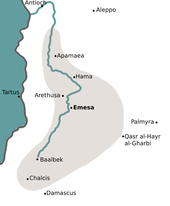
The Osroeni and Hatrans were part of several Arab groups or communities in upper Mesopotamia, which also included the Arabs of Adiabene which was an ancient kingdom in northern Mesopotamia, its chief city was Arbela (Arba-ilu), where Mar Uqba had a school, or the neighboring Hazzah, by which name the later Arabs also called Arbela. This Arab presence in upper Mesopotamia was acknowledged by the Sasanians, who called the region Arbayistan, meaning "land of the Arabs", is first attested as a province in the Ka'ba-ye Zartosht inscription of the second Sasanian King of Kings, Shapur I (r. 240–270), which was erected in c. 262. The Emesene were a dynasty of Arab priest-kings that ruled the city of Emesa (modern-day Homs, Syria) in the Roman province of Syria from the 1st century CE to the 3rd century CE. The dynasty is notable for producing a number of high priests of the god El-Gabal, who were also influential in Roman politics and culture. The first ruler of the Emesene dynasty was Sampsiceramus I, who came to power in 64 CE. He was succeeded by his son, Iamblichus, who was followed by his own son, Sampsiceramus II. Under Sampsiceramus II, Emesa became a client kingdom of the Roman Empire, and the dynasty became more closely tied to Roman political and cultural traditions.



